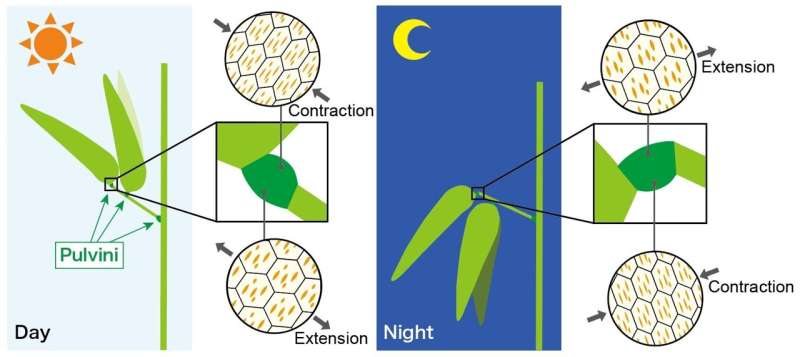This article has been reviewed according to Science X's editorial process and policies. Editors have highlighted the following attributes while ensuring the content's credibility:
fact-checked
proofread
Pulvinar slits in the cell wall of legume motor cells facilitate control of leaf movement

Plant movement has long fascinated many researchers. Legumes are a group of plants famous for exhibiting various leaf movements, including "nyctinastic movement," in which the leaves open in the day and close at night. Similar plant movements include blue light-induced and touch-sensitive movements, such as in sensitive plants like Mimosa pudica.
Movement in leaf structures is caused by repeated and reversible extension and contraction of motor cells, which are the cells in a structure called the pulvinus at the base of the leaflets and petioles. Such repetitive and reversible cell extension and contraction are very rare in plant cells, which are surrounded by a rigid cell wall. Moreover, it is not well understood how motor cells are capable of repetitive and reversible extension and contraction.
Plant cell walls are composed of a number of cellulose microfibrils that shrink or expand in response to osmotic concentration differences between the inside and outside of the cell. However, the amount of change that can be induced by anisotropy in the arrangement of cellulose microfibrils cannot explain the full range of movement of the pulvinus.
A research team led by Miyuki Nakata and Taku Demura at the Nara Institute of Science and Technology (NAIST) examined the cross-sections of pulvinar motor cells from Desmodium paniculatum using confocal laser microscopy to investigate the mechanism of repetitive and reversible cell extension and contraction. They identified unique circumferential "slits" in the cell wall of the motor cells that contained less cellulose. The structures were conserved across two subfamilies of legumes, including soybeans, kudzu and sensitive plants.
Upon transferring tissue slices from legume cortical motor cells to solutions of different osmolarity, the pulvinar slits increased in width, indicating a mechanism by which plant cell walls could flex in response to solutions of different osmolarity.
Through a combination of detailed cell wall analysis, computer simulations, and observations of pulvinar slits in cells undergoing extension and contraction, pulvinar slits were determined to be mechanically flexible structures that open and close during cell extension and contraction.
"Computer modeling suggested that pulvinar slits facilitate anisotropic extension in the direction perpendicular to the slits in the presence of turgor pressure," says Miyuki Nakata. The researchers compared the action to the straight cuts or slits used in kirigami, a Japanese papercraft, to enhance the extensibility of the paper sheet.
Thus, the research team proposed that these unique, pulvinar slits are structures that act to allow more movement of the cortical motor cells than would otherwise be allowed by the typical cellulose microfibrils in the cell wall.
"We provide a hypothesis that pulvinar slits have a role in dynamic leaf movement through repetitive and reversible deformation of cortical motor cells in concert with other factors including cellulose orientation, pectin-rich composition of the cell wall, the geometry of cortical motor cells, and the actin cytoskeleton," says Miyuki Nakata.
The study is published in the journal Plant Physiology.
More information: Masahiro Takahara et al, Pulvinar slits: Cellulose-deficient and de-methyl-esterified pectin-rich structures in a legume motor cell, Plant Physiology (2023). DOI: 10.1093/plphys/kiad105
Provided by Nara Institute of Science and Technology




















